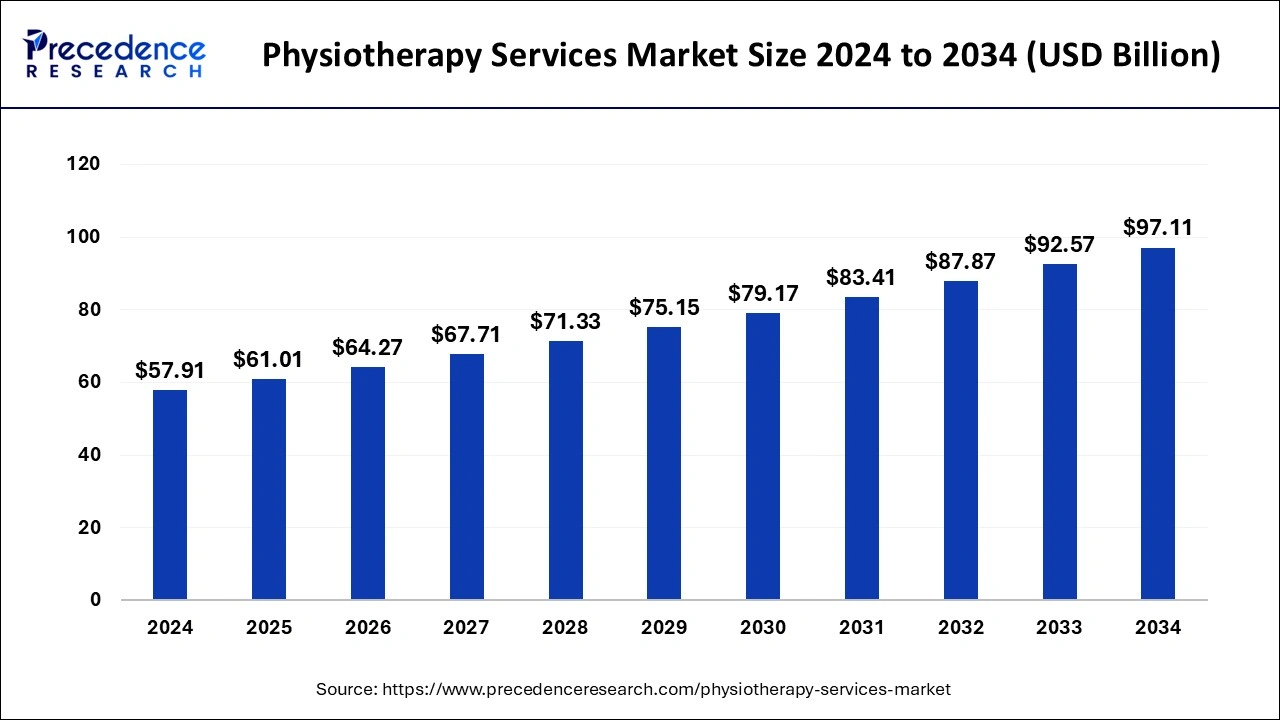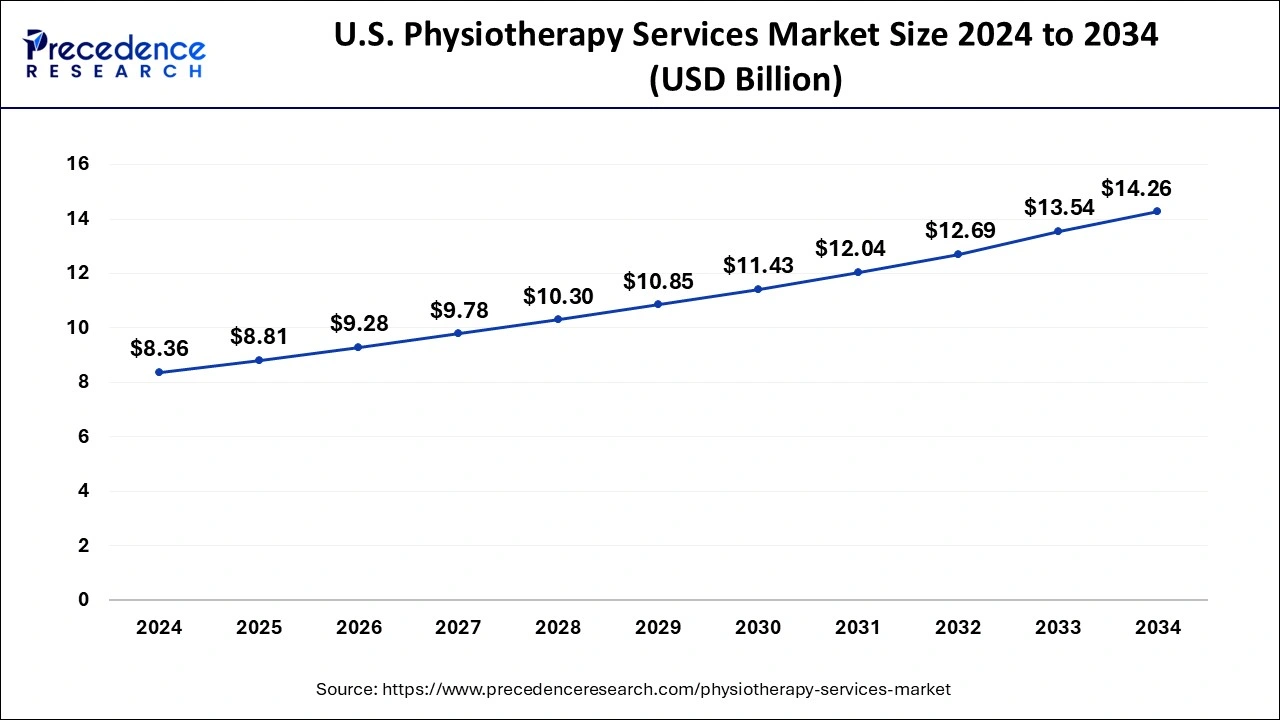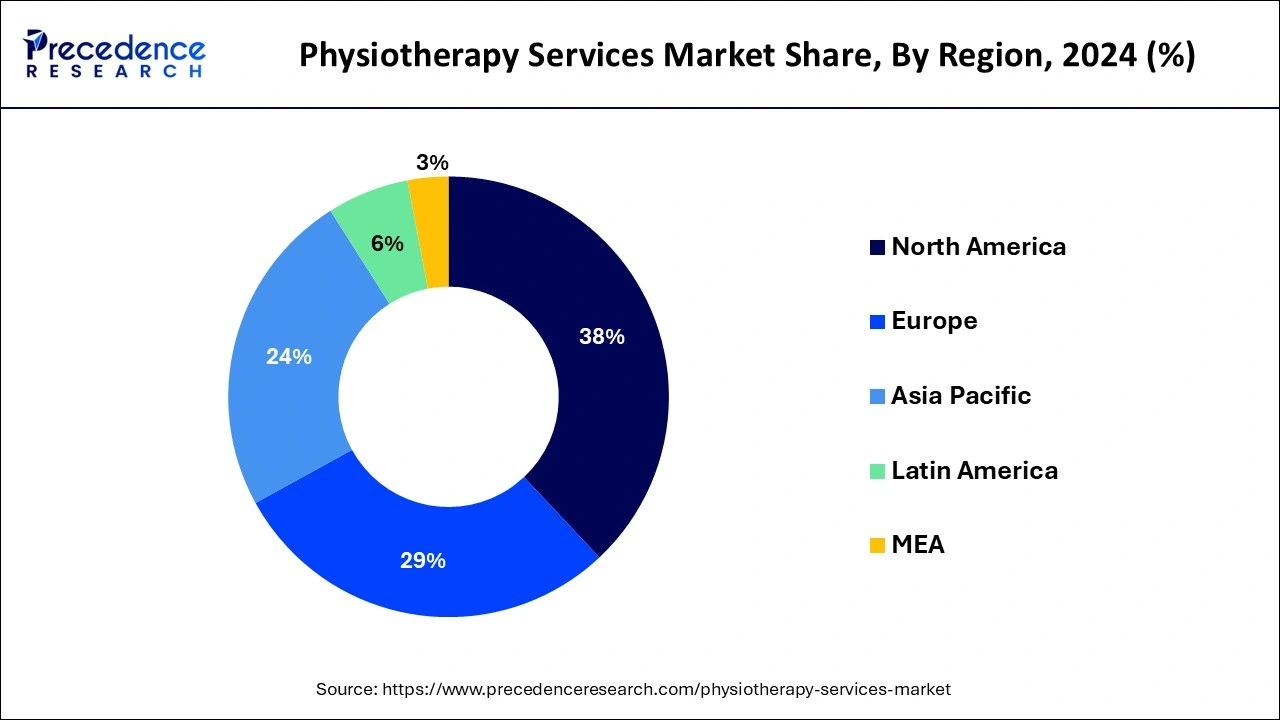January 2025
The global physiotherapy services market size is accounted at USD 61.01 billion in 2025 and is forecasted to hit around USD 97.11 billion by 2034, representing a CAGR of 5.31% from 2025 to 2034. The North America market size was estimated at USD 22.01 billion in 2024 and is expanding at a CAGR of 5.35% during the forecast period. The market sizing and forecasts are revenue-based (USD Million/Billion), with 2024 as the base year.
The global physiotherapy services market size accounted for USD 57.91 billion in 2024 and is predicted to increase from USD 61.01 billion in 2025 to approximately USD 97.11 billion by 2034, expanding at a CAGR of 5.31% from 2025 to 2034.

The U.S. physiotherapy services market size was exhibited at USD 8.36 billion in 2024 and is projected to be worth around USD 14.26 billion by 2034, growing at a CAGR of 5.49% from 2025 to 2034.

North America has emerged as the dominant region, in 2024. The region is observed to sustain as a leader during the forecast period. North America boasts advanced healthcare infrastructure, including state-of-the-art facilities, well-trained healthcare professionals, and robust regulatory frameworks, which support the development and delivery of high-quality physiotherapy services. The region is at the forefront of technological innovations in healthcare, with significant investments in telehealth platforms, wearable devices, and digital health solutions. These advancements enhance access to physiotherapy services, improve patient engagement, and enable remote monitoring and tele-rehabilitation thus, driving market growth.
The increasing prevalence of these conditions contributes to the high demand for physiotherapy services in the region. With a large and active aging population, there is a heightened focus on healthy aging, mobility, and functional independence in North America. Physiotherapy plays a crucial role in promoting mobility, preventing falls, and enhancing quality of life among older adults, further driving market growth.

Asia Pacific has emerged as a fast-growing region in the physiotherapy services market. The region is experiencing rapid urbanization and industrialization, leading to lifestyle changes, increased sedentary behaviours-lifestyle, and a rise in chronic diseases and musculoskeletal disorders. As a result, there is a growing demand for physiotherapy services to address these health issue. Many countries in Asia Pacific such as India, China, Indonesia etc are investing heavily in healthcare infrastructure development, including the establishment of hospitals, clinics, and rehabilitation centres. This expansion improves access to physiotherapy services, particularly in underserved rural areas.
Rising disposable incomes and government initiatives to improve healthcare access are driving increased healthcare spending in the Asia Pacific region. This includes investment in preventive and rehabilitative healthcare services, such as physiotherapy, to address the growing burden of chronic diseases and injuries.
Asia Pacific is embracing technological advancements in healthcare, including telehealth platforms, digital health solutions, and wearable devices like smart watches. These technologies enhance the delivery of physiotherapy services, improve patient outcomes, and expand access to care, contributing to the region's fast-paced growth in the physiotherapy services market.
The physiotherapy services market is experiencing significant growth driven by several factors. Increasing awareness about the importance of physical therapy for rehabilitation, injury prevention, and overall wellness is expanding the demand for these services. Additionally, the aging population and rising incidence of chronic diseases are driving the need for physiotherapy interventions.
Technological advancements, such as telehealth platforms and wearable devices, are enhancing access to physiotherapy services, especially in remote areas. Moreover, the integration of evidence-based practices and personalized treatment plans is improving patient outcomes and satisfaction. However, challenges such as reimbursement issues, workforce shortages, and regulatory constraints may hinder market growth. At the end, the physiotherapy services market is poised for further expansion as it continues to play a crucial role in promoting mobility, function, and quality of life for individuals across various age groups and health conditions.
| Report Coverage | Details |
| Growth Rate from 2025 to 2034 | CAGR of 5.31% |
| Market Size in 2025 | USD 61.01 Billion |
| Market Size in 2024 | USD 57.91 Billion |
| Market Size by 2033 | USD 97.11 Billion |
| Largest Market | North America |
| Base Year | 2024 |
| Forecast Period | 2025 to 2034 |
| Segments Covered | Physiotherapy Type, Service Providers, and End-user |
| Regions Covered | North America, Europe, Asia-Pacific, Latin America, and Middle East & Africa |
Increasing rate of chronic diseases
Rising chronic diseases rate is a significant driver for the physiotherapy services market. With an aging population and changing lifestyle patterns, there's been a notable surge in chronic conditions such as cardiovascular diseases, diabetes, arthritis, and obesity-related disorders. These conditions often lead to impaired mobility, decreased function, and chronic pain, necessitating long-term management and rehabilitation.
Physiotherapy plays a crucial role in managing chronic diseases by focusing on improving mobility, strength, flexibility, and overall functional ability. Through targeted exercises, manual therapy techniques, and patient education, physiotherapists help individuals regain independence, manage symptoms, and improve their quality of life. Moreover, physiotherapy interventions can prevent complications, reduce the need for medication, and lower healthcare costs associated with chronic disease management.
Furthermore, the holistic approach of physiotherapy addresses not only the physical symptoms but also the psychological and social aspects of chronic conditions, promoting overall well-being and self-management skills. As the burden of chronic diseases continues to rise globally, the demand for physiotherapy services is expected to increase proportionally. This trend underscores the importance of integrating physiotherapy into comprehensive healthcare strategies to effectively manage chronic diseases, enhance patient outcomes, and alleviate the strain on healthcare systems.
Affordability
High costs associated with physiotherapy services can act as a significant restraint on the physiotherapy services market. While physiotherapy is recognized as an effective intervention for rehabilitation, injury prevention, and wellness promotion, the expenses involved in accessing these services can be prohibitive for many individuals. Particularly with underprivileged and rural areas and people having lesser incomes.
Factors contributing to the high cost of physiotherapy services include the specialized training and expertise of physiotherapists, advanced equipment and facilities used in a treatment, and the duration and frequency of treatment sessions required for optimal results, which generally takes time to heal the body. Additionally, depending on the healthcare system and insurance coverage in place, patients may face out-of-pocket expenses for physiotherapy services, particularly for treatments not fully reimbursed.
Online physiotherapy services
Online physiotherapy services represent a promising future opportunity for the physiotherapy services market. Advancements in telehealth technology, coupled with changing patient preferences and the need for convenient healthcare solutions, have paved the way for the expansion of online physiotherapy services.
These platforms offer patients the flexibility to access physiotherapy consultations, exercises that require and guidance remotely thus, eliminating the need for in-person visits and overcoming geographical barriers. Patients can connect with licensed physiotherapists through video calls, chat messages, or mobile apps, receiving personalized treatment plans and ongoing support from the comfort of their homes. Online physiotherapy services also enhance accessibility for individuals with mobility issues, those living in remote areas, or those facing transportation challenges. Additionally, they promote continuity of care by enabling regular follow-ups and progress tracking, improving treatment and patient outcomes.
As the demand for convenient healthcare solutions continues to grow, online physiotherapy services are poised to play an increasingly integral role in the delivery of rehabilitation, injury prevention, and wellness promotion services. With ongoing technological advancements and regulatory support, the future of the physiotherapy services market is bright, with online services driving innovation and expanding access to care.
The orthopaedic physiotherapy segment led the physiotherapy services market in 2024. The growth of this segment is driven by an aging population and increasing prevalence of orthopaedic conditions such as osteoarthritis, fractures, and musculoskeletal injuries, there is a growing demand for specialized rehabilitation services. Orthopaedic physiotherapy focuses on the assessment, diagnosis, and treatment of musculoskeletal disorders and injuries, aiming to restore mobility, strength, and function while reducing pain and preventing recurrence. This segment incorporates a spectrum of interventions, including manual therapy techniques, therapeutic exercises, modalities such as ultrasound and electrical stimulation, and patient education on injury prevention and self-management strategies.
Moreover, advancements in orthopaedic surgery techniques, such as joint replacements and arthroscopic procedures, have created opportunities for post-operative rehabilitation, further driving the demand for orthopaedic physiotherapy services. Additionally, the emphasis on sports medicine and injury prevention has expanded the scope of orthopaedic physiotherapy to include athletes and active individuals seeking to optimize performance and prevent injuries, further propelling market growth.
The rehabilitation centres segment emerged as the dominating one in 2024 in the physiotherapy services market. There is an increasing recognition of the importance of comprehensive rehabilitation services in managing a wide range of conditions, including orthopaedic injuries, neurological disorders, sports injuries, and chronic diseases. Rehabilitation centres offer a multidisciplinary approach, combining physiotherapy with other therapeutic modalities such as occupational therapy, speech therapy, and mental health counselling to address the diverse needs of patients. Rehabilitation centres develop specialized treatment programs tailored to the unique needs of each patient, incorporating evidence-based practices and advanced technologies to optimize outcomes. These programs may include intensive rehabilitation for neurological conditions, post-surgical rehabilitation, pain management, and functional restoration.
Rehabilitation centres further leverage advanced technologies such as robotics, virtual reality, and wearable devices to enhance therapy outcomes, improve patient engagement, and track progress more accurately. These technologies enable personalized treatment approaches and facilitate remote monitoring and tele-rehabilitation services, expanding access to care for patients in remote or underserved areas.
Rehabilitation centres emphasize a comprehensive approach to wellness, addressing not only physical impairments but also psychological, social, and environmental factors that impact recovery and quality of life. This comprehensive approach promotes long-term health and well-being, making rehabilitation centres an essential component of the healthcare sector.
The adults segment dominated the physiotherapy services market in 2023. With a growing population globally, the demand for physiotherapy services among adults has increased significantly. Age-related conditions such as osteoarthritis, osteoporosis, and degenerative disc diseases often require ongoing physiotherapy interventions to maintain mobility and functionality.
Adults are more prone to chronic diseases such as cardiovascular disorders, diabetes, and musculoskeletal conditions, which needs a physiotherapy for management and rehabilitation. Physiotherapy plays a crucial role in optimizing outcomes and improving quality of life for adults with chronic conditions.
Many adults engage in sports and fitness activities, leading to sports injuries or the need for performance enhancement. Physiotherapy services cater to this segment by providing rehabilitation, injury prevention, and performance optimization strategies. Adults are often affected by work-related musculoskeletal injuries or ergonomic issues, requiring physiotherapy interventions for pain management and functional restoration.
By Physiotherapy Type
By Service Providers
By End-user
By Geography
For inquiries regarding discounts, bulk purchases, or customization requests, please contact us at sales@precedenceresearch.com
No cookie-cutter, only authentic analysis – take the 1st step to become a Precedence Research client
January 2025
January 2024
March 2025
January 2025